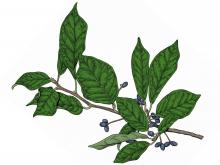Trees, Shrubs and Woody Vines
Media

Species Types
Scientific Name
Platanus occidentalis
Description
The white, smooth-looking limbs of sycamore rise over countless streams and river banks, as well as over sidewalks and city streets. The leaves, which somewhat resemble those of maples, can reach remarkably large sizes.
Media

Species Types
Scientific Name
Nyssa sylvatica
Description
A close relative of water tupelo, black gum is very popular as a landscaping tree. In the wild, it’s usually found in the Ozarks and Bootheel, but with its high popularity in landscaping, you might find it anywhere in the state.
Media

Species Types
Scientific Name
Diospyros virginiana
Description
Persimmon is best known in the fall, when its orange, plumlike fruits come on. Be careful, however, to make sure a persimmon is ripe before you pop it into your mouth, or you could have a puckery surprise!
Media

Species Types
Scientific Name
Maclura pomifera
Description
Osage orange is a densely branched, short-trunked, thorny tree. It bears weird-loooking, softball-sized, chartreuse, brainlike fruits, which often lie beneath the tree in abundance in autumn.
Media

Species Types
Scientific Name
Cornus alternifolia
Description
Dogwoods usually have leaves arranged opposite one another on the stem, except for the alternate-leaved dogwood! This shrub or small tree is a popular ornamental, especially in the northern parts of Missouri, where it can be too cold to grow flowering dogwood.
Media

Species Types
Scientific Name
Cornus spp.
Description
Missouri’s five species of dogwoods are shrubs or small trees with distinctive flowers, fruits, and bark. The fruits may be red, white, or blue. The leaves have characteristic arching veins.
Media

Species Types
Scientific Name
Toxicodendron radicans
Description
Poison ivy is a toxic plant that contains an oil in all its parts that, if you come into contact with it, can cause an intense skin reaction. Learn to recognize it, and sidestep it on your outings.
Media

Species Types
Scientific Name
Cocculus carolinus
Description
Carolina moonseed is a slender, twining vine. It is scattered in southern and eastern Missouri. It bears clusters of bright red, somewhat flattened fruits. The disk-shaped seeds are spiraled like a snail shell.
See Also
About Trees, Shrubs and Woody Vines in Missouri
There are no sharp dividing lines between trees, shrubs, and woody vines, or even between woody and nonwoody plants. “Wood” is a type of tissue made of cellulose and lignin that many plants develop as they mature — whether they are “woody” or not. Trees are woody plants over 13 feet tall with a single trunk. Shrubs are less than 13 feet tall, with multiple stems. Vines require support or else sprawl over the ground.





















